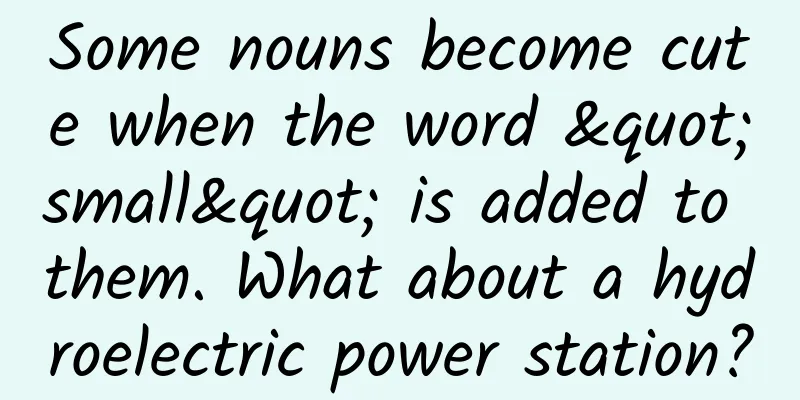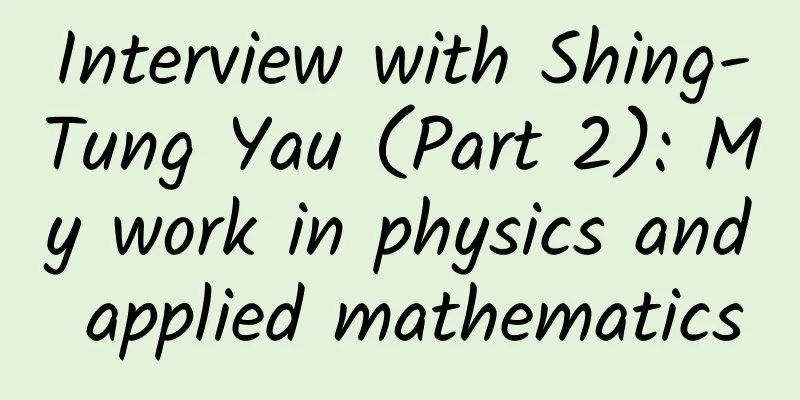Some nouns become cute when the word "small" is added to them. What about a hydroelectric power station?

|
Produced by: Science Popularization China Author: Cheng Mingchen (popular science creator) Producer: China Science Expo Whether it is the birth of the four ancient civilizations or the establishment of modern megacities, all of them are located on the banks of the rivers. The reason is simple: the fertile soil and abundant water resources in the river basins provide excellent conditions for agricultural development. Large-scale agricultural activities support more people, which naturally supports the development of civilization and the expansion of cities. In this sense, rivers have nurtured our human civilization. Location of the four ancient civilizations (Photo source: Homemade) Today, in addition to traditional irrigation and domestic water, rivers also provide us with the most important thing that supports modern civilization: energy. Relying on a series of hydropower stations built on rivers, we can obtain cheap and clean energy. In recent years, the development of new energy sources such as wind power and photovoltaics has been rapid, but according to the analysis and forecast report released by the International Energy Agency, hydropower currently accounts for about 16% of the world's total electricity generation, making it the renewable energy source with the largest capacity, and will still maintain a proportion of 16% in 2025. The birth of a hydropower station The birth of hydropower stations is inseparable from water wheels. People have been making water wheels to utilize water power for a long time. Among them, China has a very long history of using water wheels. At the end of the reign of Emperor Wu of the Han Dynasty, around 100 BC, the prototype of modern water turbines appeared in my country, the water wheel, which was used for irrigation and driving grain processing equipment. Subsequently, water energy utilization entered its heyday during the Song and Yuan dynasties, and hydraulic machinery such as the world-leading water-powered astronomical observatory and water-powered spinning wheel came into being. Unfortunately, these technologies were soon buried in history. After entering the Ming and Qing dynasties, my country's water energy utilization technology completely stagnated. Reconstruction of a water-powered spinning wheel (Photo source: China Science and Technology Museum) In the early 18th century, the French invented the reaction turbine, but it was inefficient. In 1849, American James Francis improved it and developed the first modern water turbine, which marked the beginning of the practical use of water energy. Patent drawing of a modern water turbine in 1880 (Image source: Wikipedia) With the invention and maturity of generators, the combination of "turbine + generator" made its debut. In 1882, the world's first hydroelectric power station was built along the Fox River in Wisconsin, USA, which opened the curtain of hydroelectric power generation. Since then, a wave of hydropower development has emerged around the world. In 1910, the 36th year of Emperor Guangxu's reign in the Qing Dynasty, my country finally built its first hydropower station, the Shilongba Hydropower Station, located in the upper reaches of the Mantis River in Kunming, Yunnan Province. It was funded and built by businessman Wang Xiaozhai, with a height of 15 meters. By introducing advanced foreign technology and equipment at the time, including Voith turbines and German Siemens generators, it supplied electricity to Kunming, 32 kilometers away from the power station. The first workshop of Shilongba Hydropower Station is the first hydropower station in China. The couplet on the gate reads "The machine is born from nature, and the instrument is exquisite and wonderful with the help of water", and the lintel reads "The light of the bright moon", which reflects people's understanding of hydropower at that time. (Image source: Wikipedia) Is it generating electricity when the dam gates are opened to release water? No Although there are many different ways to generate electricity, there are many similarities. For example, most of the methods of generating electricity cannot be separated from a generator (except photovoltaic power generation), such as thermal power, hydropower, wind power, etc. In order to drive the generator to rotate, the power source at the front end (steam, water flow, air, etc.) needs to convert its own linear motion into rotational motion through the impeller machinery (steam turbine, water turbine, wind turbine). In other words, only moving water can generate electricity, but the water stored in the dam reservoir cannot generate electricity directly, it needs to convert its own energy into kinetic energy first. With the above knowledge, we will naturally understand that hydroelectric power generation is actually the use of turbines to convert the gravitational potential energy of water into electrical energy. Many people may have seen the spectacular sight of water rushing down when the dam is opened to release water, and may also take it for granted that this is the hydroelectric power station generating electricity, but this is not the case. The Three Gorges Dam is opening the gates to release water (Image source: Wikipedia) While hydroelectric power does rely on gravitational potential energy, it does not refer to the water pouring out of the dam, but the water inside the dam. The deeper the water in the dam, specifically, the greater the vertical height from the horizontal surface of the dam to the inlet of the turbine (technically called the head), the greater the gravitational potential energy. When the sluice gates are opened, water flows out of the gates and drives the turbine to rotate, converting the gravitational potential energy into mechanical energy, which is converted into electrical energy through a generator connected to the turbine. How Hydropower Stations Work (Image source: Wikipedia) Hydropower Station: I also want to be friends with fish Hydropower is an important clean energy source, but if it is not constructed properly, it can also cause some ecological problems. First, the construction of dams may destroy the migration paths and habitats of aquatic animals; second, the rotation of turbines may also cause harm to aquatic animals, especially fish. The reasons why fish are injured when passing through turbines can be divided into four categories: collision, water pressure, vortex and cavitation. During the high-speed rotation of the turbine, fish are easily hit by the blades when passing through the turbine; the turbine will cause a drastic change in water pressure, causing damage to the fish's swim bladder; the rapidly rotating vortex will also draw the fish in, causing them to be subjected to greater shear force; the rotation of the turbine will also produce cavitation bubbles, which will also produce high-pressure shock waves when they burst on the surface of the fish. Fish movement at the inlet of an axial flow impeller (Image source: Reference [6]) Improving fish-friendliness is one of the current development trends of hydropower stations. The international community attaches great importance to this topic. Fish survival rate is an important indicator for evaluating the eco-friendliness of hydropower projects. Although improvements to existing turbines can reduce damage to fish, developing new turbines can fundamentally solve the problem. In response to this, in 1993, the American Alden Company launched a uniquely shaped Alden turbine , which only uses three spiral blades and is equipped with a rotating cover to eliminate vortices, allowing fish to pass through the gap between the blades and the seat ring. However, the results of the model experiment show that there are still small vortices in the tailwater pipe, which may make the fish dizzy, but compared with traditional turbines, its safety has been greatly improved. Alden turbine (Image source: Reference [5]) After years of continuous and active exploration, the design level of my country's fish-friendly turbines has steadily improved, and good results have been achieved. It has been applied and promoted in many hydropower stations. **In addition to turbines, dams are also a big challenge for fish. Building a fish ladder for fish can help them cross the dam and go upstream. **A fish ladder is actually a ladder for fish. By setting up waterways with gentle slopes, barriers and other obstacles to slow down the flow of water, and pools and other places for fish to rest, a channel for fish to go up is opened up. Fish can swim upstream, rest after reaching the pool above, and then repeat the process until they leave the ladder and finally jump over the "Dragon Gate". Fish ladder at John Day Dam, USA (Image source: Wikipedia) Since the beginning of this century, my country has attached great importance to the construction of fish ladders in hydropower stations, and has also specially issued the standard "Guidelines for the Design of Fishways for Water Conservancy and Hydropower Projects-SL609-2013". During the construction of the Wudongde Hydropower Station, in order to protect the fish in the river to the greatest extent, engineers customized a "straight elevator" for the fish. It is a tailwater fish collection device. A fish collection station and fish collection box are set up at the tailwater discharge outlet of the generator set. The fish's nature of swimming upstream is used to induce them to enter the "elevator", and then the "elevator" is quickly lifted to the upstream of the dam. Statistics show that since the Wudongde Hydropower Station was put into operation in 2020, this "elevator system" has helped more than 1,000 fish every day. Small Hydropower Station: Big guy, you can't steal my friends In addition to large hydropower stations, many people do not know that there are also small hydropower stations. Small hydropower stations can protect the health and safety of fish to the greatest extent by diverting water to form tributaries to generate electricity. With the continuous development and maturity of technology, the efficiency of turbines is getting higher and higher, and hydropower stations are getting larger and larger. Although large-scale hydropower stations can bring huge benefits such as flood control, power generation, shipping, breeding, tourism, and irrigation, there is not much room for development of large-scale hydropower stations. The next step can only be to infiltrate small hydropower stations. Small hydropower stations have always been often overlooked. In fact, for every large hydropower station built, 11 small hydropower stations will be built. Although the standards of large and small vary according to different countries, it is undeniable that the contribution of small hydropower stations to energy and electricity is not inferior to that of large hydropower stations. However, these small hydropower stations often have a more harmonious relationship with the surrounding environment, reflecting the concept of harmonious development between man and nature. Small hydropower stations can be roughly divided into four categories according to whether there are tributaries and whether there are reservoirs. Four types of small hydropower plants Image source: The Ecological Society of America Although hydropower stations can be divided into large and small categories based on different perspectives such as dam height, water storage capacity, rated power generation or investment cost, there is no strict unified definition for the two. Relatively speaking, small hydropower stations are more friendly to the surrounding ecological environment. However, it is not easy to find completely scientific evidence, because "fish cannot step into the same river twice", and it is almost impossible to find two completely similar rivers to conduct a set of control experiments. However, compared with large hydropower plants, small hydropower plants generally do not completely block the river, so fish can pass through the dam more freely. In addition, the water pressure of large hydropower dams is greater, the turbine blades are larger and more lethal, and the noise generated can also affect the communication between fish, which is completely different from the situation of small hydropower plants. Small hydropower stations actually have a certain positive effect on the surrounding ecological environment. For example, the filter installed in front of the dam can filter out waste in the water, keep the river clean, and slow down the flow of water and improve the pollution of the river bank. This is more conducive to the fish to "live and work in peace and contentment"! Conclusion The construction of any hydropower station deserves careful and repeated demonstration. We believe that the continuous exploration of scientific researchers and the continuous advancement of technology will promote the harmonious development of man and nature. Various clean and renewable energy sources (Image source: alamy, translated by the author) References [1] Thiago BA Couto* and Julian D Olden. Global proliferation of small hydropower. plants – science and policy. 2018; 16(2): 91–100, doi: 10.1002/fee.1746. [2] Final Report – Pilot Scale Tests Alden/Concepts NREC Turbine. US Department of Energy, Advanced Hydropower Turbine Systems Program, 2003. [3] Twaróg B., The Development of Small Hydropower-Plants in the Low Mountain Range, Final Report, Cracow University of Technology, February 2014. [4] Final Turbine and Test Facility Design Report Alden/NREC Fish Friendly Turbine, Prepared by Alden Research Laboratory, Inc. Northern Research and Engineering Corporation for the US Department of Energy Idaho Operations Office, September 2000. [5]Fish Friendly Hydropower Turbine Development and Deployment: Alden Turbine Preliminary Engineering and Model Testing. Final Report, October 2011. Electric Power Research Institute, October 2011. [6] Yang Dandan. Movement behavior and damage analysis of fish in axial flow pump[D]. Beijing: Tsinghua University. 2021. |
<<: Food is the first necessity of the people. Learn about rice aerospace breeding
>>: Why is blood sugar still out of control when eating and exercising together? Here’s the reason…
Recommend
"The Earth weighs about 6 ronna grams"
Four new prefixes added to international units Ki...
Himalaya product operation analysis
In my childhood memory, there was always a radio ...
Crowdfunding is not lending: just talking about money is not enough
Recently, the popularity of crowdfunding has exce...
What does Microsoft's acquisition of Tiktok mean for ByteDance? What are the impacts?
What does Microsoft's acquisition of Tiktok m...
WeChat secretly accesses photo albums. Are these apps really that rebellious?
[[428187]] I don’t know if you guys still remembe...
Introduction to PP Assistant promotion effects and advertising promotion cases!
pp assistant promotion case introduction Promotio...
The "college entrance examination" in the home appliance industry is more difficult. Who can laugh out of the examination room?
In the hot June, we ushered in the hot college en...
Tik Tok video copywriting operation skills tutorial
Douyin video copywriting operation skills tutoria...
60 episodes of Ankasment Jung's Analytical Psychology Theory and Practice Workshop online course video
Ann Casement Jung Analytical Psychology Theory an...
When is the exact date of the 2020 US election? The US election is getting closer, and Biden accepts the presidential nomination
The US election is getting closer, and Biden has ...
I accidentally ate this fruit and my mouth swelled up like a sausage!
Review expert: Shi Jun, Ph.D. in botany, well-kno...
How to use the Foshan maternal and child mini program? How to promote the maternal and child mini program mall?
After the country relaxed the "three-child p...
Marketing strategy: How should social e-commerce platforms deal with the “mass exodus of promoters” during the “big reshuffle”?
There are currently four mainstream tracks in the...
The smoking rate among women is not high, so why is the lung cancer rate so high?
Lung cancer is the most common primary malignant ...
What kind of content can attract users' attention? Try these 6!
What kind of content can attract users' atten...







![[One Belt, One Road Story] The "pioneers" heading towards the sun](/upload/images/67f2334158cd9.webp)

